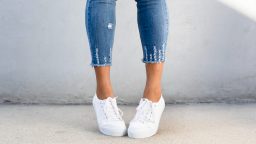The fashion industry has long been associated with fast fashion, which often leads to overconsumption, waste, and environmental harm. However, in recent years, there has been a shift towards sustainable fashion – a movement focused on reducing the negative impact on the environment while still allowing individuals to express their personal style. As more consumers become aware of the environmental and ethical issues tied to clothing production, sustainable fashion is gaining traction. Here are some of the top sustainable fashion trends you need to follow to help make your wardrobe more eco-friendly while staying stylish.
- Slow Fashion
At the core of sustainable fashion is the concept of „slow fashion.” Unlike fast fashion, which encourages the constant purchase of cheap, disposable items, slow fashion promotes the idea of buying fewer, high-quality pieces that last longer. Slow fashion focuses on timeless, durable designs that won’t go out of style. Instead of constantly refreshing your wardrobe with new items, slow fashion encourages mindful consumption and thoughtful purchasing decisions. This trend not only reduces waste but also ensures that you’re investing in pieces that will remain in your closet for years to come.
- Secondhand and Vintage Shopping
One of the easiest ways to incorporate sustainability into your wardrobe is by shopping secondhand and vintage. Thrift stores, online resale platforms, and consignment shops have become increasingly popular, offering a wide range of unique, high-quality items at a fraction of the price. By choosing secondhand clothing, you’re giving garments a second life and helping reduce the demand for new clothing production. Vintage pieces also add a touch of individuality to your style, allowing you to create one-of-a-kind outfits that stand out. Vintage shopping not only saves money but also supports the circular economy, where clothes are reused and recycled.
- Upcycling and DIY Fashion
Upcycling, or transforming old garments into something new, is another sustainable fashion trend that’s gaining popularity. Instead of throwing away clothes that are no longer in good condition or that no longer fit, why not get creative and give them a new purpose? Upcycling can involve simple tasks like turning old jeans into a skirt, adding patches to a worn jacket, or reworking a vintage shirt into a trendy new style. DIY fashion allows you to express your creativity while also reducing waste. Plus, it’s a fun way to add unique, custom-made pieces to your wardrobe.
- Clothing Rental Services
Clothing rental services are a fantastic way to enjoy new styles without contributing to the cycle of overconsumption. Many companies now offer rental options for special events, everyday wear, or even high-end designer pieces. This trend allows you to enjoy a variety of outfits without having to buy new items that you’ll only wear once. Whether you need a dress for a wedding, a suit for a business event, or even casual wear for the season, rental services help reduce textile waste by giving you access to high-quality clothes without the commitment to ownership. This trend is perfect for anyone looking to expand their wardrobe sustainably.
- Natural and Organic Fabrics
Sustainable fashion trends are also shifting towards the use of natural and organic fabrics, which have a lower environmental impact than synthetic materials. Organic cotton, hemp, linen, and bamboo are great alternatives to traditional fabrics like polyester or nylon. These materials are biodegradable and require fewer pesticides and chemicals to grow, making them more eco-friendly. Additionally, many brands are now experimenting with innovative fabrics like mushroom leather or fabric made from recycled ocean plastic. By choosing clothing made from these materials, you’re supporting a fashion industry that’s moving towards more sustainable practices.
- Ethical and Transparent Brands
Consumers are becoming more conscious of where their clothes come from and the conditions under which they’re made. As a result, ethical and transparent fashion brands are on the rise. These brands focus on fair wages, safe working conditions, and ethical sourcing of materials. Many sustainable fashion labels are now providing full transparency about their supply chains, ensuring that customers know exactly where and how their clothes are made. When shopping for sustainable fashion, look for brands that prioritise ethical practices, such as using fair trade-certified materials and providing workers with a living wage. Supporting these brands helps promote a more ethical and responsible fashion industry.
- Clothing Care and Repair
Taking good care of your clothing can extend its life and reduce the need to buy new items. Sustainable fashion isn’t just about the clothes you buy – it’s also about how you maintain and care for them. Learning how to properly wash, store, and repair your clothes can significantly reduce wear and tear, making them last longer. Many fashionistas are embracing clothing repair techniques, such as patching holes, sewing on missing buttons, or even re-dyeing faded garments. By investing in clothing care and repair, you can ensure that your wardrobe remains in great condition without constantly needing to replace items.
- The Rise of Eco-Friendly Fashion Accessories
Sustainable fashion isn’t limited to clothing – accessories are also becoming more eco-friendly. From bags made from recycled materials to shoes crafted with sustainable production methods, there’s an increasing range of stylish and environmentally conscious accessories available. Many brands are turning to sustainable materials like cork, recycled plastic, and vegan leather to create chic bags, shoes, and belts. These accessories not only look great but also help reduce the environmental footprint of your entire outfit. By choosing sustainable accessories, you can complement your wardrobe while supporting ethical and eco-friendly brands.
- Local and Small-Batch Designers
Supporting local and small-batch designers is another way to embrace sustainable fashion. Small designers often prioritise quality over quantity, using ethical production methods and sustainable materials to create their collections. Shopping from local designers or small businesses helps reduce the carbon footprint associated with mass production and long-distance shipping. Additionally, you’re more likely to find unique, handcrafted pieces that aren’t mass-produced, giving you a more individualistic and sustainable wardrobe.
Conclusion
Sustainable fashion is no longer a niche trend – it’s becoming an essential part of the fashion industry. From slow fashion and secondhand shopping to the rise of ethical brands and eco-friendly materials, there are countless ways to incorporate sustainability into your wardrobe. By following these sustainable fashion trends, you can reduce your environmental impact, support ethical practices, and still look stylish. Fashion may evolve, but the future of fashion is undoubtedly rooted in sustainability. Make mindful choices, and you’ll be contributing to a more sustainable and responsible fashion industry for generations to come.





